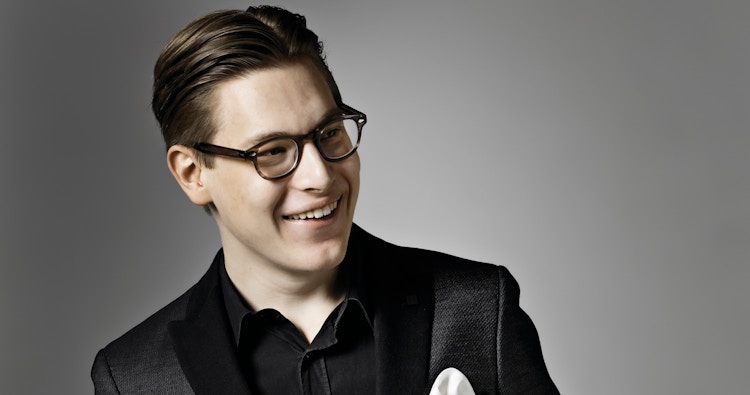Debussy Salonen Ravel Mäkelä
French Impressions − Finnish Visions

French Impressions − Finnish Visions
Our Principal Conductor Designate, Klaus Mäkelä, leads a programme of Finnish and French music.
The first work on the programme is one of Debussy’s most colourful and radical orchestra works: the composer’s Images. Truls Mørk performs Esa-Pekka Salonen’s new Cello Concerto, from 2017, and the concert concludes with Ravel’s hypnotic Bolero − a French-Spanish orchestra classic and audience favourite.
Maurice Ravel (1875−1937) originally composed Bolero as a ballet, commissioned by the Russian dancer, Ida Rubenstein. The work was premiered as a ballet in 1928, and was an immediate success, eventually becoming one of Ravel’s most famous compositions. After the world premiere, it became common to perform the work without choreography. Bolero is mainly characterised by the many repetitions of the bolero rhythm and the Spanish-inspired melody which wanders through the orchestra. The whole work is composed as one, consecutive crescendo. The snare drum introduces the bolero rhythm tentatively and softly in the beginning while the melody itself is played pianissimo by a flute. Gradually, the sound and intensity increase, more instruments and instrument groups join in − both in the rhythmical motive and the melody itself − until the frenetic climax where the whole orchestra plays fortissimo possibile − as loudly as possible.
Like Ravel, Claude Debussy (1862−1918) was inspired by Spanish music and culture, something which characterises the second of his three Images for orchestra, Iberia. Here, Debussy uses both castanets and guitars, giving the music a distinct Spanish colour as it evokes life in the Spanish streets, the distinct mood of the Spanish night and the anticipation building up to a real fiesta. Like Debussy’s other works, Images has a French sensibility; a sensitivity to sound and an innovative approach to it. In Gigues, the music circles around an English folk song, but this is placed in a French context − namely, Debussy’s colourful writing for orchestra and his rich harmonic palate of sounds. Rondes de Printemps is a very French, “Debussyesque” celebration of spring: more introverted and tentative, but every bit as colourful as Stravinsky’s Rite of Spring. Images was composed between 1905 and 1912.
With the same sensitivity to sound and inventive approach to composing as the French masters from near and distant past, Finnish composer Esa-Pekka Salonen (b.1958) has established himself as one of the leading composers and conductors of our time. One of his most recent works is his Cello Concerto, written for Yo-Yo Ma and premiered by the famous cellist in Chicago in 2017. Salonen has said that he enjoys writing for the cello instrument, not only because of the enormous span in its expressive potential, but also because the instrument has such a distinct “human” quality in its sound. “Besides, I like the idea of a virtuoso performer who operates right on the border of what is physically (and sometimes mentally) possible”.
New French music was not always well-received in Norwegian music circles in the time between the wars. When the Oslo Philharmonic performed Ravel’s Bolero for the first time in Norway, in 1931, the German music-orientated and conservative critic, Per Reidarson, was clearly not very impressed by the repetitive new music, writing in a review in Arbeiderbladet:
We heard yet a new work: Bolero by Ravel. Here, the worldly, but otherwise not very talented French composer has invented a fiery, beautiful and typically Spanish Bolero theme. He introduces the work with this theme, which then makes its rounds through a series of wind instruments, accompanied by a soft pizzicato and small drum which constantly plays the Bolero beat. The theme is played through all the wind instruments and finally arrives at the strings, but nothing comes of it. One waits forever for a contrasting movement, or some other variation. But no. There is just more of the same, and the only adjustment is in the role of the instruments. At first it is entertaining, but after a while, the joke has gone too far. It is just like a humorous rhyme with a hundred verses. It’s amusing the ten first times, and the rest is too much. Schneevoigt conducted with energy and good humour, and got what he could out of the works.
(Text: Thomas Erma Møller; Translation from Norwegian: Sarah Osa; In photo: Klaus Mäkelä; Photo: Heikki Tuuli)
What is played
- Claude Debussy Images
- Esa-Pekka Salonen Cello Concerto
- Maurice Ravel Bolero
Duration
Performers
-
Klaus Mäkelä
Conductor -
Truls Mørk
Cello -
Ella Wahlström
Sound design
Tickets
Prices
| Price groups | Price |
|---|---|
| Adult | 120 - 490 NOK |
| Senior | 120 - 395 NOK |
| Student | 120 - 245 NOK |
| Child | 120 NOK |
Subscription
Debussy Salonen Ravel Mäkelä